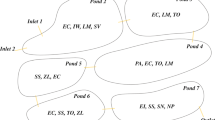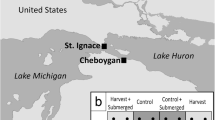Abtract
This experiment tested the hypothesis that the movement of water into the soil due to macrophyte transpiration stimulates nitrate removal from wetlands. The short-term impacts of biomass harvesting upon the ability of wetlands to reduce nitrate concentrations were also investigated. Different amounts of biomass were harvested fromTypha latifolia specimens to create three treatments of varying transpiration rates. Harvesting and the resulting different rates of transpiration explained between 10 and 38% of the variation in nitrate reduction during the 10-day experiment and had significant effects upon nitrate concentrations. Greater rates of harvesting and lower rates of transpiration resulted in decreased reductions of nitrate in the surface water of the microcosms. During the first four days of the experiment, 70% and 85% rates of aboveground harvesting reduced transpiration by 63% and 91%, respectively. These changes led to respective decreases in nitrate reduction of 16% and 31% compared to unharvested treatments. Differences in nitrate reduction between the treatments were minimal in the later days of the experiment as nitrate concentrations decreased. Results support the hypothesis that water movement due to plant uptake contributes, to nitrogen removal and offers a partial explanation for increased nitrogen removal in vegetated wetland treatment systems. Decreased reduction of nitrate with greater harvesting demonstrates potential negative impacts on water quality improvement when using wetlands as bio-energy production systems.
Similar content being viewed by others
Literature cited
Abtew, W., S. Newman, K. Pietro and T. Kosier. 1995. Canopy resistance studies of cattails. Transactions of the American Society of Agricultural Engineers 38:113–119.
Allen, R. G., J. H. Prueger and R. W. Hill. 1992. Evapotranspiration from isolated stands of hydrophytes: cattail and bulrush. Transactions of the American Society of Agricultural Engineers 35: 1191–1198.
Allirand, J. M. and G. Gosse. 1995. An above-ground biomass production model for a common reed (Phragmites communis Trin.) stand. Biomass and Bioenergy 9:441–448.
AOAC. 1990. Official Methods of Analysis. 15th ed. Method 990.03. Protein (crude) in Animal Feed Combustion Method (Dumas method). The Association. Arlington, VA, USA.
Bachand, P. A. M. and A. J. Horne. 2000a. Denitrification in constructed free-water surface wetlands: I. Very high nitrate removal rates in a macrocosm study. Ecological Engineering 14:9–15.
Bachand, P. A. M. and A. J. Horne. 2000b. Denitrification in constructed free-water surface wetlands: II. Effects of vegetation and temperature. Ecological Engineering 14:17–32.
Bjork, S. and W. Graneli. 1978. Energy reeds and the environment. Ambio 7:150–155.
Bowmer, K. H. 1987. Nutrient removal from effluents by an artificial wetland: influence of rhizosphere aeration and preferential flow studied using bromide and dye tracers. Water Research 21:591–599.
Brix, H. and H. H. Schierup. 1989. The use of aquatic macrophytes in water-pollution control. Ambio 18:100–107.
Cheng, S., V. C. Zeljka, W. Grosse, and F. Karrenbrock. 2002. Xenobiotics removal from polluted water by a multifunctional constructed wetland. Chemosphere 48:415–418.
Crites, R. W. and G. Tchobanoglous. 1991. Water Environment Research 64:920.
Deren, C. W., G. H. Snyder, P. Y. P. Tai, C. E. Turick, and D. P. Chynoweth. 1991. Biomass production and biochemical methane potential of seasonally flooded inter-generic and inter-specific Saccharum hybrids. Bioresource Technology 36:179–184.
Eriksson, P. G. and S. E. B. Weisner. 1999. An experimental study on effects of submersed macrophytes on nitrification and denitrification in ammonium-rich aquatic systems. Limnology and Oceanography 44:1993–1999.
Farahbakhshazad, N., G. M. Morrison, A. Larsson, and S. E. B. Weisner. 1995. Effects of grain size on nutrient removal from wasterwater in small-scale planted macrophyte system. p. 143–150.In R. Ramadori, L. Cingolani, and L. Cameroni (eds.) Natural and Constructed Wetlands for Wasterwater Treatment and Reuse. IAWQ Italian National Committee, Perugia, Italy.
Fleming-Singer, M. S. and A. J. Horne. 2002. Enhanced nitrate removal efficiency in wetland microcosms using an episediment layer for denitrification. Environmental Science and Technology 36: 1231–1237.
Garver, E. G., D. R. Dubbe, and D. C. Pratt. 1988. Seasonal patterns in accumulation and partitioning of biomass and macronutrients in Typha spp. Aquatic Botany 32:115–127.
Gersberg, R. M., S. R. Lyon, R. Brenner, and B. V. Elkins. 1989. Integrated wastewater treatment using artificial wetlands: a gravel marsh case study. p. 145–152.In D. A. Hammer (ed.) Constructed Wetlands for Wastewater Treatment: Municipal, Industrial, and Agricultural. Lewis Brothers, Chelsea, MI, USA.
Gersberg, R. M., B. V. Elhns, S. R. Lyon, and C. R. Goldman. 1986. Role of aquatic plants in wastewater treatment by artificial wetlands. Water Resources 20:363–368.
Giovannini, S. G. T. and D. M. L. Motta Marques. 1999. Establishment of three emergent macrophytes under different water regimes. Water Science and Technology 40:233–240.
Granelli, W. 1984. ReedPhragmites-austalis (cav) trin ex steudel as an energy-source in Sweeden. Biomass 4:183–208.
Kadlec, R. H. 1995. Design models for nutrient removal in constructed wetlands. p. 173–184.In K. Steele (ed.) Animal Waste and the Land-Water Interface. Lewis Publishers, Boca Raton, FL, USA.
Kadlec, R. H. and R. L. Knight. 1996. Treatment Wetlands. Lewis Publishers, Boca Raton, FL, USA.
Koch, M. S. and P. S. Rawlik. 1993. Transpiration and stomatal conductance of two wetland macrophytes (Cladium jamaicense andTypha domingensis) in the subtropical Everglades. American Journal of Botany 80:1146–1154.
Korner, C., J. A. Scheel, and H. Bauer. 1979. Maximum leaf diffusive conductance in vascular plants. Photosynthetica 13:45–82.
Lund, L. J., A. J. Horne, and A. E. Williams. 2000. Estimating denitrification in a large constructed wetland using stable nitrogen isotope ratios. Ecological Engineering 14:67–76.
Martin, J. F. and K. R. Reddy. 1997. Interaction and spatial distribution of wetland nitrogen processes. Ecological Modelling 105: 1–21.
Mitsch, W. J. and J. G. Gosselink. 1993. Wetlands. Van Nostrand Reinhohld. New York, NY, USA.
Moraghan, J. T. 1993. Loss and assimilation of 15N-nitrate added to a North Dakota cattail marsh. Aquatic Botany 46:225–234.
Mulvaney, R. L. 1996. Methods of Soil Analysis, Part 3, Chemical Methods. Soil Science Society of America, Madison, WI, USA.
Neori, A., K. R. Reddy, H. Ciskova-Koncalova, and M. Agami. 2000. Bioactive chemicals and biological-biochemical activities and their functions in rhizospheres of wetland plants. Botanical Review 66:350–378.
Paine, L. K., T. L. Peterson, D. J. Undersander, K. C. Rineer, G. A. Bartelt, S. A. Temple, D. W. Sample, and R. M. Klemme. 1996. Some ecological and socio-economic considerations for biomass energy crop production. Biomass and Bioenergy 10:231–242.
Rao, P. S. C., R. E. Jessup, and K. R. Reddy. 1984. Simulation of nitrogen dynamics in flooded soils. Soil Science 138:54–62.
Reddy, K. R., E. M. D'Angelo, and T. A. DeBusk. 1990. Oxygen transport through aquatic macrophytes: the role in wastewater treatment. Journal of Environmental Quality 19:261–267.
Reddy, K. R., W. H. Patrick, and C. W. Lindau. 1989. Nitrification-denitrification as the plant root-sediment interface in wetlands. Limnology and Oceanography 34:1004–1013.
Reddy, K. R. and W. H. Patrick. 1984. Nitrogen transformations and loss in flooded soils and sediments. CRC Critical Reviews in Environmental Control 13:273–309.
Reed, S. C. and D. S. Brown. 1992. Constructed wetland design—the first generation. Water Environment Research 64:776–781.
Reuter, I. E., T. Djohan, and C. R. Goldman. 1992. The use of wetlands for nutrient removal from surface runoff in a cold climate region of California-results from a newly constructed wetland at Lake Tahoe. Environmental Management 36:35–53.
Reilly, J. F., A. J. Horne, and C. D. Miller. 2000. Nitrate removal from a drinking water supply with large free-surface constructed wetlands prior to groundwater recharge. Ecological Engineering 14:33–47.
Rogers, K. H., P. F. Breen, and A. J. Chick. 1991. Nitrogen removal in experimental wetland treatment systems: evidence for the role of aquatic plants. Research Journal of the Water Pollution Control Federation 63:934–941.
Smith, C. J. and R. D. DeLaune. 1984. Influence of the rhizosphere of Spartina alterniflora Loicel on nitrogen loss from a Louisiana Gulf Coast salt marsh. Environmental and Experimental Botany 24:91–93.
Soto, F., M. Garcia, E. de Luis, and E. Becares. 1999. Role of scirpus lacustris in bacterial and nutrient removal from wastewater. Water Science and Technology 40:241–247.
Weisner, S. E. B, P. G. Eriksson, W. Graneli, and L. Leonardson. 1994. Influence of macrophytes on nitrate removal in wetlands. Ambio 6:363–367.
Wetzel, P. R. and A. G. Van der Valk. 1998. Effects of nutrient and soil moisture on competition betweenCares stricta, Phalaris arundinacea, andTypha latifolia. Plant Ecology 138:179–190.
White, J. R. and K. R. Reddy. 1999. Influence of nitrate and phosphorus loading on denitrifying enzyme activity in Everglades wetland soils. Soil Science Society of America Journal 63:1945–1954.
Yang, L., H. T. Chang, and M. L. Huang. 2001. Nutrient removal in gravel- and soil-based wetland microcosms with and without vegetation. Ecological Engineering 18:91–105.
Zellweger Analytics, Inc. 1999. Methods Manual. Lachat Instruments Division. Milwaukee, WI, USA.
Author information
Authors and Affiliations
Rights and permissions
About this article
Cite this article
Martin, J., Hofherr, E. & Quigley, M.F. Effects ofTypha latifolia transpiration and harvesting on nitrate concentrations in surface water of wetland microcosms. Wetlands 23, 835–844 (2003). https://doi.org/10.1672/0277-5212(2003)023[0835:EOTLTA]2.0.CO;2
Received:
Revised:
Accepted:
Issue Date:
DOI: https://doi.org/10.1672/0277-5212(2003)023[0835:EOTLTA]2.0.CO;2




